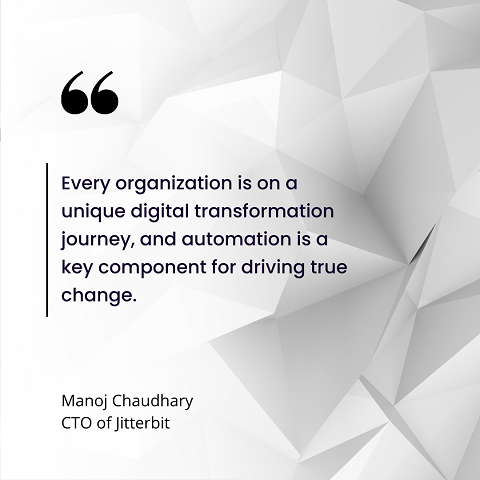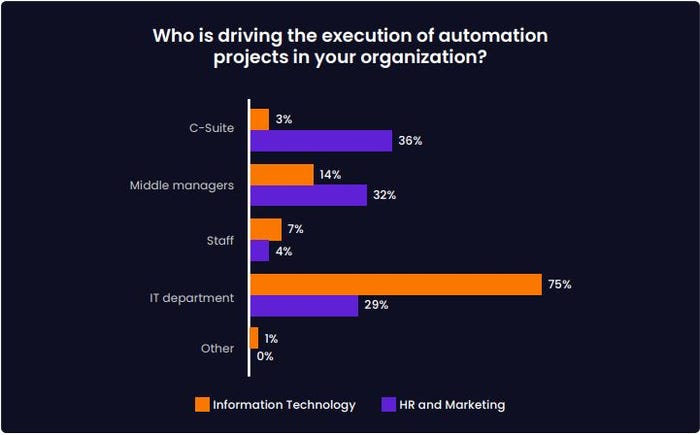Jitterbit: Only 33% of IT Leaders Believe They Outpace Rivals in AutomationJitterbit: Only 33% of IT Leaders Believe They Outpace Rivals in Automation
Jitterbit's 2023 State of Automation: IT report finds that most companies are embracing automation but few have confidence they are doing as well as others.

Integration and automation provider Jitterbit on Aug. 17 released its 2023 State of Automation: IT report, identifying a number of automation trends and challenges.
The poll of IT, marketing, and HR executives found that operational optimization and economic pressures are driving automation adoption, though security, cost, and complexity remain top challenges.
While IT departments spearhead automation efforts, line-of-business (LOB) participation is rising as software-as-a-service (SaaS) apps require integration with legacy systems.

Chaudhary-Jitterbit
The Jitterbit report also found that 89% of companies are prioritizing business process automation this year, but only one-third believe they lead competitors.
The key takeaways from the report:
Business process automation is a top priority for IT teams to remain competitive
Operational optimization fuels the demand for automation
IT teams lead the charge in automation initiatives
"Every organization is on a unique digital transformation journey, and automation is a key component for driving true change," Manoj Chaudhary, CTO of Jitterbit, told ITPro Today.
Organizations' Perceived State of Automation Varies by Role
One of the more unexpected results in the report is the perceived differences in the state of automation based on role.
Chaudhary said he was a bit surprised to see a measurable difference between the perception IT leaders have of their role in driving automation compared with other departmental perspectives on IT's role.
According to the report, more than 70% of IT leaders believe they are driving automation initiatives in their organization, but fewer than 30% of HR and marketing leaders agree.

automation-drivers
According to Chaudhary, that difference in perception likely means one of two things: Businesses are struggling with data silos and information asymmetry as a result of a disconnected tech stack, or there is now a power shift happening — thanks to no/low-code tools — that is enabling departmental leaders to drive more of their own automation projects.
"Either way, strategic collaboration and alignment between business leaders is crucial for successful automation," he said. "Integration is the missing piece that helps connect and unify data across departments to accelerate automation."
Why Many Organizations Feel They Are Behind in Automation
Only one-third of respondents to the Jitterbit survey feel they are ahead of their competitors when it comes to implementing automation. While organizations recognize the benefits of automation, a majority of IT leaders feel they are only keeping pace or falling behind their competitors.
More than half (56%) of IT leaders are very or extremely concerned about their competitors' initiatives to automate digital processes and workflows.
"As markets across verticals grow oversaturated, organizations with more streamlined operations and innovative processes will drive better internal and external experiences, giving them a competitive edge," Chaudhary said.
It's difficult for organizations to scale their automation initiatives in a meaningful way without the right strategy, support, tools, budget, and resources in place — and it's even more difficult for organizations to make automation strides when one or more of those elements are missing, according to Chaudhary. In addition, it is becoming increasingly hard to keep up with the application landscape with new technologies continuously entering the market, he said.
"It is easy to feel behind and assume that your competitors are outpacing you or have a more scalable solution in place," he said.
Common Challenges of IT Automation
Regarding the obstacles to automating business processes, organizations ranked security and data privacy, cost, complexity, lack of IT resources, and governance as their top five challenges.
As businesses scale and processes get more complicated, Chaudhary stressed thatautomation is a critical component of streamlining workflows and improving business processes for greater operational efficiencies.
The majority of respondents (63%) agreed that IT directors are the key stakeholders driving decisions around organizational automation strategies. According to Chaudhary, this likely demonstrates that these decisions are still being made within IT departments, while the majority of integrations (74%) being managed by IT — 51% of integrations are being managed solely by central IT teams and 23% by central IT and LOB departments together.
"It is likely that central IT's continued involvement in the vast majority of integration projects is contributing to the overwhelming workload and pressure put on IT resources," he said.
In Chaudhary's view,IT teams alone cannot drive this transformation in organizations. Due to tightening budgets and resource constraints, LOB team members are gaining more autonomy when it comes to driving automation initiatives.
"By empowering and educating LOB users to take on more automation responsibilities with the right tools and security guardrails in place, you can accelerate time to value, amplify digital transformation, and free up IT teams to focus on more strategic initiatives," he said.
About the Author
You May Also Like








.jpg?width=700&auto=webp&quality=80&disable=upscale)
